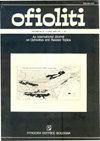PETROLOGY OF MANTLE PERIDOTITES AND INTRUSIVE MAFIC ROCKS FROM THE KERMANSHAH OPHIOLITIC COMPLEX (ZAGROS BELT, IRAN): IMPLICATIONS FOR THE GEODYNAMIC EVOLUTION OF THE NEO-TETHYAN OCEANIC BRANCH BETWEEN ARABIA AND IRAN
IF 1.3
4区 地球科学
Q2 GEOLOGY
引用次数: 63
Abstract
The Kermanshah ophiolitic complex consists of a melange formation, which includes dismembered ophiolitic sequences. These ophiolites are located along the Main Zagros Reverse Fault, which marks the ophiolitic suture zone between the Zagros belt and the Sanandaj-Sirjan zone. They represent the Neo- Tethyan oceanic lithosphere, which originally existed between the Arabian (to the south) and Eurasian (to the north) continental margins. The Kermanshah ophiolites were emplaced onto platform carbonate rocks, which represented the northeastern Arabian margin. The Kermanshah ophiolitic complex is composed of various partial sequences, which are represented by: (1) mantle tectonites consisting of depleted lherzolites and both clinopyroxene- (cpx-) rich and cpx-free harzburgites; (2) a troctolite-cumulate gabbro-isotropic gabbro sequence mainly showing pegmatoid texture; (3) a wehrlite-cumulate gabbro-isotropic gabbro sequence showing foliated texture; (4) a dyke complex; (5) very scarce pillow basalts. Mantle tectonites are volumetrically predominant and tectonically overlay the gabbroic sequences. A number of conclusions may be drawn based on petrographic observations, mineral chemistry, whole-rock chemistry, and rare earth elements (REE) modelling carried out on both mantle tectonites and intrusive rock associations. (1) The Foliated Gabbro Unit has an N-MORB chemical signature and represents a portion of oceanic crust generated in a mid-ocean ridge setting from an N-MORB-type sub-oceanic mantle. (2) The Pegmatoid Gabbro Unit displays an E-MORB signature and represents a portion of oceanic crust most likely generated from a sub-oceanic mantle source enriched in light REE (LREE). A comparison with the well-studied Oman ophiolites suggests that this sequence may have formed during the early stage of oceanic spreading. (3) The depleted lherzolites present mild depletions in heavy REE (HREE) and variable depletion in LREE. REE modelling shows that they may represent a residual mantle after 15-20% removal of N-MORB melts. Some lherzolites show a moderate enrichment in La and Ce with respect to Sm, suggesting that this residual MORB mantle was subsequently trapped in a supra-subduction zone (SSZ) mantle wedge and enriched in LREE by subduction-derived fluids. (4) The depleted harzburgites present a significant depletion in incompatible elements and REE, coupled with a marked LREE enrichment with respect to medium REE. REE modelling shows that they may represent a residual mantle after 25-30% removal of boninitic-type melts in an intra-oceanic arc setting.伊朗扎格罗斯带kermanshah蛇绿杂岩的地幔橄榄岩和侵入基性岩的岩石学:对阿拉伯-伊朗之间新特提斯大洋分支地球动力学演化的意义
克尔曼沙蛇绿杂岩由混杂岩组成,其中包括断裂的蛇绿岩序列。这些蛇绿岩位于Zagros主逆断层沿线,标志着Zagros带与Sanandaj-Sirjan带之间的蛇绿岩缝合带。它们代表了新特提斯海洋岩石圈,最初存在于阿拉伯(南部)和欧亚(北部)大陆边缘之间。克尔曼沙蛇绿岩位在台地碳酸盐岩上,代表了阿拉伯东北缘。Kermanshah蛇绿杂岩由不同的部分层序组成,主要表现为:(1)地幔构造岩由贫辉绿岩和富斜辉绿岩(cpx-)和不含cpx-的哈兹布尔岩组成;(2)以伟晶岩结构为主的橄榄长岩-堆积辉长岩-各向同性辉长岩层序;(3)辉长岩-堆积辉长岩-各向同性辉长岩层序,呈片理结构;(4)堤防复合体;(5)非常稀缺的枕玄武岩。地幔构造岩在体积上占主导地位,构造上覆盖于辉长岩层序之上。根据对地幔构造岩和侵入岩组合进行的岩石学观察、矿物化学、全岩化学和稀土元素(REE)模拟,可以得出许多结论。(1)片理辉长岩单元具有N-MORB化学特征,代表了N-MORB型海底地幔在洋中脊背景下形成的一部分洋壳。(2)伟晶状辉长岩单元具有E-MORB特征,代表了极有可能由富含轻稀土元素(LREE)的海底地幔源形成的部分洋壳。与阿曼蛇绿岩的对比表明,该层序可能形成于海洋扩张的早期阶段。(3)贫辉橄榄岩重稀土(HREE)轻度贫,轻稀土(LREE)轻度贫。稀土元素模拟表明,它们可能是N-MORB熔体去除15-20%后的残余地幔。部分玄武岩表现出相对于Sm的中度富集La和Ce,表明该残余MORB地幔随后被困在超俯冲带(SSZ)地幔楔中,并通过俯冲衍生流体富集LREE。(4)亏缺的哈尔茨堡土中不相容元素和稀土元素明显亏缺,相对于中稀土元素,轻稀土元素明显富集。稀土元素模拟表明,它们可能是洋内弧背景下,博尼岩型熔体去除25-30%后的残余地幔。
本文章由计算机程序翻译,如有差异,请以英文原文为准。
求助全文
约1分钟内获得全文
求助全文
来源期刊

Ofioliti
地学-地质学
CiteScore
2.40
自引率
7.70%
发文量
1
期刊介绍:
Since 1976, Ofioliti provides an international forum for original contributions and reviews in the field of the geodynamics, petrology, geochemistry, biostratigraphy, stratigraphy, tectonics and paleogeography applied to ophiolitic terrains and modern oceanic lithosphere, including their sedimentary cover. Studies of topics such as geodynamics of the mantle, the evolution of orogens including ophiolites and paleoceanography are also welcome
 求助内容:
求助内容: 应助结果提醒方式:
应助结果提醒方式:


